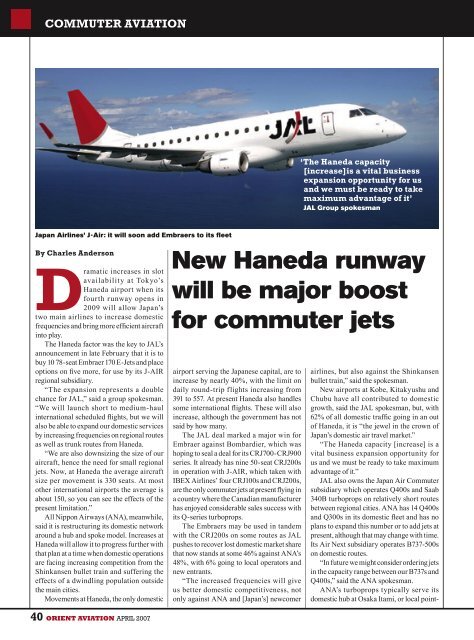Fleet Census - Orient Aviation
Fleet Census - Orient Aviation
Fleet Census - Orient Aviation
Create successful ePaper yourself
Turn your PDF publications into a flip-book with our unique Google optimized e-Paper software.
COMMUTER AVIATION<br />
‘The Haneda capacity<br />
[increase]is a vital business<br />
expansion opportunity for us<br />
and we must be ready to take<br />
maximum advantage of it’<br />
JAL Group spokesman<br />
Japan Airlines’ J-Air: it will soon add Embraers to its fleet<br />
By Charles Anderson<br />
Dramatic increases in slot<br />
availability at Tokyo’s<br />
Haneda airport when its<br />
fourth runway opens in<br />
2009 will allow Japan’s<br />
two main airlines to increase domestic<br />
frequencies and bring more efficient aircraft<br />
into play.<br />
The Haneda factor was the key to JAL’s<br />
announcement in late February that it is to<br />
buy 10 78-seat Embraer 170 E-Jets and place<br />
options on five more, for use by its J-AIR<br />
regional subsidiary.<br />
“The expansion represents a double<br />
chance for JAL,” said a group spokesman.<br />
“We will launch short to medium-haul<br />
international scheduled flights, but we will<br />
also be able to expand our domestic services<br />
by increasing frequencies on regional routes<br />
as well as trunk routes from Haneda.<br />
“We are also downsizing the size of our<br />
aircraft, hence the need for small regional<br />
jets. Now, at Haneda the average aircraft<br />
size per movement is 330 seats. At most<br />
other international airports the average is<br />
about 150, so you can see the effects of the<br />
present limitation.”<br />
All Nippon Airways (ANA), meanwhile,<br />
said it is restructuring its domestic network<br />
around a hub and spoke model. Increases at<br />
Haneda will allow it to progress further with<br />
that plan at a time when domestic operations<br />
are facing increasing competition from the<br />
Shinkansen bullet train and suffering the<br />
effects of a dwindling population outside<br />
the main cities.<br />
Movements at Haneda, the only domestic<br />
New Haneda runway<br />
will be major boost<br />
for commuter jets<br />
airport serving the Japanese capital, are to<br />
increase by nearly 40%, with the limit on<br />
daily round-trip flights increasing from<br />
391 to 557. At present Haneda also handles<br />
some international flights. These will also<br />
increase, although the government has not<br />
said by how many.<br />
The JAL deal marked a major win for<br />
Embraer against Bombardier, which was<br />
hoping to seal a deal for its CRJ700-CRJ900<br />
series. It already has nine 50-seat CRJ200s<br />
in operation with J-AIR, which taken with<br />
IBEX Airlines’ four CRJ100s and CRJ200s,<br />
are the only commuter jets at present flying in<br />
a country where the Canadian manufacturer<br />
has enjoyed considerable sales success with<br />
its Q-series turboprops.<br />
The Embraers may be used in tandem<br />
with the CRJ200s on some routes as JAL<br />
pushes to recover lost domestic market share<br />
that now stands at some 46% against ANA’s<br />
48%, with 6% going to local operators and<br />
new entrants.<br />
“The increased frequencies will give<br />
us better domestic competitiveness, not<br />
only against ANA and [Japan’s] newcomer<br />
airlines, but also against the Shinkansen<br />
bullet train,” said the spokesman.<br />
New airports at Kobe, Kitakyushu and<br />
Chubu have all contributed to domestic<br />
growth, said the JAL spokesman, but, with<br />
62% of all domestic traffic going in an out<br />
of Haneda, it is “the jewel in the crown of<br />
Japan’s domestic air travel market.”<br />
“The Haneda capacity [increase] is a<br />
vital business expansion opportunity for<br />
us and we must be ready to take maximum<br />
advantage of it.”<br />
JAL also owns the Japan Air Commuter<br />
subsidiary which operates Q400s and Saab<br />
340B turboprops on relatively short routes<br />
between regional cities. ANA has 14 Q400s<br />
and Q300s in its domestic fleet and has no<br />
plans to expand this number or to add jets at<br />
present, although that may change with time.<br />
Its Air Next subsidiary operates B737-500s<br />
on domestic routes.<br />
“In future we might consider ordering jets<br />
in the capacity range between our B737s and<br />
Q400s,” said the ANA spokesman.<br />
ANA’s turboprops typically serve its<br />
domestic hub at Osaka Itami, or local point-<br />
40 ORIENT AVIATION APRIL 2007








![OAMag-V7N4-Cover [Converted] - Orient Aviation](https://img.yumpu.com/48598575/1/190x255/oamag-v7n4-cover-converted-orient-aviation.jpg?quality=85)








